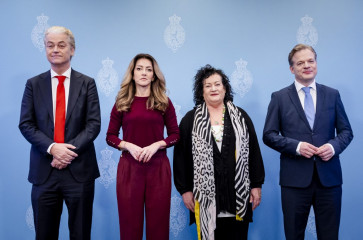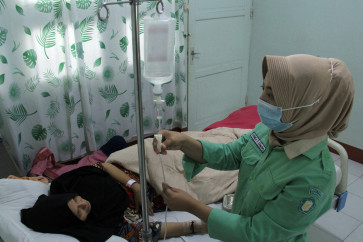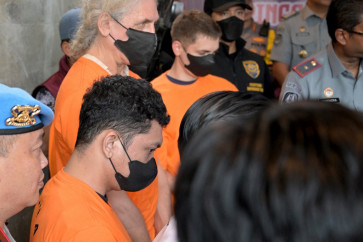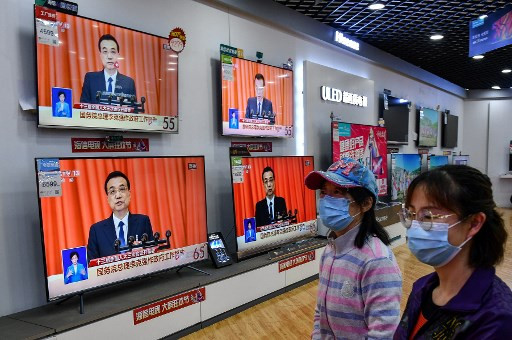Museums and heritage need business support to shine
Prominent businessman Hashim Djojohadikusumo is now not only busy doing business but also promoting Indonesian heritage, especially artifacts, fossils and wildlife
Change Size

P
em>Prominent businessman Hashim Djojohadikusumo is now not only busy doing business but also promoting Indonesian heritage, especially artifacts, fossils and wildlife. His love of Indonesian archeological heritage has made him active in many heritage foundations and led him to establish his own Hashim Djojohadikusumo Family Foundation (YKHD). The government has also asked his help in facilitating the return of the 1000-year-old Sanggurah Stone, or Minto Stone, from Lord Minto in Scotland. He promised to bring back the 3.8-ton stone tablet by the end of this year using his own money.
Hashim, son of Soemitro Djojohadikusumo, the late prominent economist from the Sukarno and Soeharto eras, uses fortunes from his multi-billion-dollar global businesses to pursue his love of collecting Indonesian artifacts from around the world. But his hunt for Indonesian artifacts hit a snag recently when the police confiscated five 9th century statues from his home in Kemang, South Jakarta, which the police said had been stolen from Radya Pustaka Museum in Surakarta, Central Java.
Hashim, however, argued he legally bought the statues from Hugo Kreijger, a Dutch art dealer and consultant for Christie's auction house in Amsterdam, who claimed to get the statues from Paku Buwono XIII Hangabehi, current ruler of the Surakarta palace. One of the five statues, Ciwa Mahadewa, is Hashim's favorite.
In an interview with Riyadi Suparno and Lilian Budianto of The Jakarta Post at his office in Midplaza building, Hashim vowed to get back the five statues. The following are excerpts from the interview.
Question: How do you see yourself in this whole affair of the five statues?
Answer: I'm a victim. I need to find out whether I'm a victim of Hugo or Heru (Suryanto, a middleman) or some other parties.
With this Surakarta incident, will you still use your money to bring back the Minto stone?
Yes. The government will not use its own money because if it did, it could set a bad precedent. Other countries which keep Indonesian ancient collections will ask for similar payment from the government if we want to have them back.
Will this incident affect your appetite for hunting for Indonesian antiques around the world?
Just last month, I went to New York to negotiate with a lady who holds many jewelry pieces from the Syailendra dynasty from the 7th to 10th centuries. I went there twice.
But now, I will be more careful. If we agree on a price, I will demand a certificate from her explaining where she got the jewelry and stating that it's legal. I don't want to be called a "buyer of stolen goods" anymore.
Next time, when I make a deal, I might need the police and prosecutors to confirm that it's legal.
But how do you define legal and illegal? In the case of the five statues, if it is true that Paku Buwono XIII Hangabehi sold the statues, is it illegal?
I am not trying to defend Hangabehi. I don't know him personally. I am in a neutral position and speaking as an art collector.
According to Christie's auction house, those statues were owned by the palace rulers, not the state. Do you think we can blame the palace rulers for selling statues belonging to them? In this case, the rulers have the rights to sell them. However, if the government or the police say they belong to the state, they have to prove it.
The fact is that the statues are collections of Radya Pustaka Museum. Your opinion?
It is still questionable who owns the museum. While the Surakarta administration said it owns the museum, it has never taken care of it. The Surakarta Palace rulers also claim it is theirs. We have to trace it back to the Dutch colonization period.
Even if the museum belongs to the administration, the palace rulers may have lent the collections and therefore, they still own them.
This is a common practice worldwide. Noblemen sold their art collections, made their castles tourist destinations and used museums to support their lives.
Why does it then become problematic in Indonesia?
We have no regulations regarding this matter. Our concern is how the palace rulers can earn money. Surakarta rulers used to have sugar factories but it was a long time ago. Now they don't have a steady stream of income.
If the government is not able to support them, the private sector can actually help them through a kind of philanthropic activity, like what I have been doing. We need to ask more entrepreneurs to get involved in taking care of our heritage.
It seems not many businessmen are interested in spending money for our heritage?
I identify a problem with our effort to encourage the private sector to contribute its money, not only for heritage, but for any philanthropic activities. There is no tax incentive like in many other countries.
Philanthropic activity here is not exempted from tax. In the United States, for example, if you spend your money on a philanthropic activity, it is tax-deductible. Here, this kind of spending is taxed. This is ridiculous.
It's similar with textbooks. Our imported textbooks are taxed, and as a result they are more expensive than those sold in the United States and Australia.
We need a paradigm shift here. Philanthropic-related activities and education must be exempted from tax. We need new thinking.
We heard you are going to build a museum?
Actually, a library. We named it Soemitro Djojohadikusumo Institute. We have submitted our proposal to have it built in an area of the University of Indonesia (UI). However, we have yet to reach an agreement on it.
We will have two kinds of libraries there. First, online. We plan to provide access to more than 5,000 online international journals to Indonesian students for free.
Second, the real library with hardcover books. We plan to supply it with 3-4 million books. By comparison, if all libraries in UI were consolidated into one library, it would only have 500,000 books. In this library, we will have a section to display a collection of my father's books.
We will also build a gallery, where I plan to keep my collection of artifacts and fossils. We also plan to buy the collection of documentary movies belonging to historian Des Alwi.
The library, gallery and also the private collection section will all be in one place. We need a total of five hectares of land.
Do you have any idea how to improve our museums?
Let me tell you, the salary of a guard in the National Museum, Jakarta, is only Rp 600,000 (US$63) a month. He is responsible for taking care of the museum, which is full of valuable items, but still he receives such a low salary.
I suggested to the Tourism Minister and his aides that they establish a national board of trustees, consisting of businessmen, who will work on museums' funding and management. Our example is the British Museum, where its board of trustees is made up of the private sector and businessmen.
This is what our foundation does currently. We help the Radya Pustaka Museum with air conditioners, computers and allowances to its guards and staffers. The guards there receive only Rp 100,000 a month in salary.
We hope other businessmen will be interested in doing similar things. They will, I guess, if there is a tax incentive for philanthropic activities.









